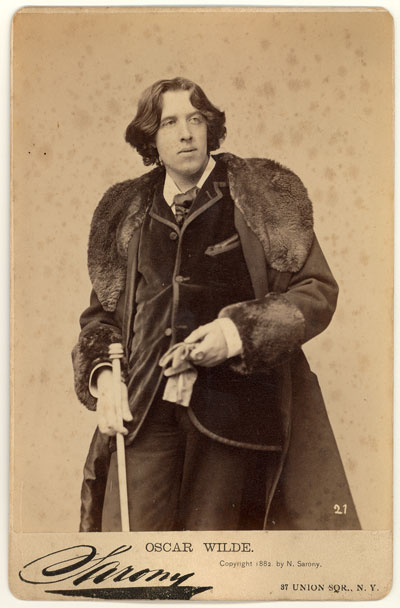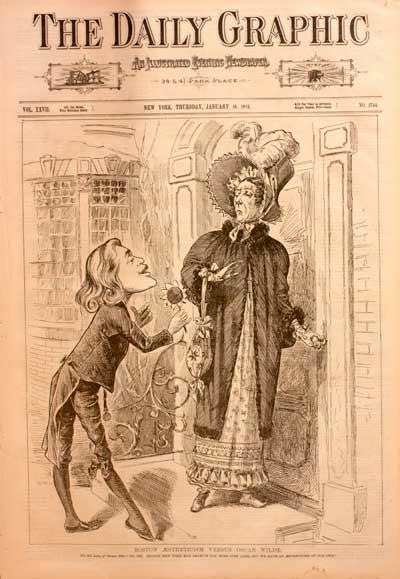Difference between revisions of "Wilson Collection: Oscar Wilde"
(Oscar Wilde) |
(Oscar Wilde) |
||
| (6 intermediate revisions by the same user not shown) | |||
| Line 4: | Line 4: | ||
''(Albumen photograph of Oscar Wilde, 1882, and front-page caricature of him | ''(Albumen photograph of Oscar Wilde, 1882, and front-page caricature of him | ||
| − | from New York’s The Daily Graphic newspaper, January 19, 1882)'' | + | from New York’s The Daily Graphic newspaper, January 19, 1882. Caption under the drawing states: "Boston Aestheticism Versus Oscar Wilde. The Old Lady of Beacon Hill--'No, Sir. Shoddy New York may receive you with open arms, but we have an aestheticism of our own.'")'' |
| − | |||
| − | |||
'''Oscar Wilde''' | '''Oscar Wilde''' | ||
| − | In 1882, in Colorado, during his American tour, miners cheered Oscar Wilde as "a bully boy with no glass eye" and named a mineshaft after him. | + | In 1882, in Colorado, during his American tour, miners cheered Oscar Wilde as "a bully boy with no glass eye" and named a mineshaft after him.<ref>Richard Ellmann, ''Oscar Wilde'' (New York: Alfred A. Knopf, 1988), 204.</ref> |
| − | But, in London, in 1895, the Irish playwright was hauled to court to face English injustice. For acting on his same-sex desires he was put on trial. Amid what his attorney called a “torrent of prejudice,” the court sentenced Wilde to prison with two years hard labor for so-called “gross indecency.” | + | But, in London, in 1895, the Irish playwright was hauled to court to face English injustice. For acting on his same-sex desires he was put on trial. Amid what his attorney called a “torrent of prejudice,” the court sentenced Wilde to prison with two years hard labor for so-called “gross indecency.”<ref>Ellmann, 476.</ref><ref>Neil McKenna, ''The Secret Life of Oscar Wilde'' (New York: Basic Books, 2005), 389, 397.</ref> Friends urged Wilde to flee. But, later, he wrote, to “have altered my life would have been to have admitted that Uranian [homosexual] love is ignoble. I hold it to be noble—more noble than other forms.”<ref>McKenna, 396.</ref> |
| − | ''References'' | + | ==''References''== |
| + | <references /> | ||
| + | |||
| + | |||
| + | |||
| + | ==''To return to "Exhibit contents" links, click:''== | ||
| + | ==[[Rich Wilson: Aspects of Queer Existence in 19th-Century America]]== | ||
| + | |||
| + | ==''See also:''== | ||
| − | + | ==[[Emma Goldman: "a great injustice," 1900-1923]]== | |
| − | |||
| − | |||
| − | |||
Latest revision as of 11:06, 26 November 2012
(Albumen photograph of Oscar Wilde, 1882, and front-page caricature of him from New York’s The Daily Graphic newspaper, January 19, 1882. Caption under the drawing states: "Boston Aestheticism Versus Oscar Wilde. The Old Lady of Beacon Hill--'No, Sir. Shoddy New York may receive you with open arms, but we have an aestheticism of our own.'")
Oscar Wilde
In 1882, in Colorado, during his American tour, miners cheered Oscar Wilde as "a bully boy with no glass eye" and named a mineshaft after him.[1]
But, in London, in 1895, the Irish playwright was hauled to court to face English injustice. For acting on his same-sex desires he was put on trial. Amid what his attorney called a “torrent of prejudice,” the court sentenced Wilde to prison with two years hard labor for so-called “gross indecency.”[2][3] Friends urged Wilde to flee. But, later, he wrote, to “have altered my life would have been to have admitted that Uranian [homosexual] love is ignoble. I hold it to be noble—more noble than other forms.”[4]
References

